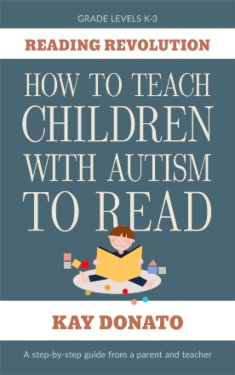| Back to Back Issues Page |
 |
|
Autism news: Sneak peek #5--Sample reading lesson plan March 04, 2022 |
| Dear Friends, Last week, I sent you an inside look from the upcoming book, Reading Revolution: How to Teach Children with Autism to Read, giving you a few tips on how to turn story time into an effective learning activity. Today, we will look at an example lesson plan from the book, which will give you an idea of how you can carry out your daily lessons. It begins with a few tips for success:  Lessons should be very simple and somewhat short, depending on how much your child can handle. How much material you cover in one lesson should depend on your child’s needs. For example, if your child can handle a few minutes only, you could spend 5 minutes on the lesson and gradually increase the time to 15 minutes based on your child’s tolerance level.
Lessons should be very simple and somewhat short, depending on how much your child can handle. How much material you cover in one lesson should depend on your child’s needs. For example, if your child can handle a few minutes only, you could spend 5 minutes on the lesson and gradually increase the time to 15 minutes based on your child’s tolerance level.
I suggest beginning most lessons with a few review words. Unless you are on your very first lesson, there should always be something you can review. Next, you should proceed with new words that your child is ready for. You can explain the meanings of some new words and some review words. Remember to give your child plenty of encouragement and praise, not only for correct answers but also for the effort being put forth. This means praising your child for the hard work and how proud you are, even if all answers are incorrect. The below lessons are examples of how you could teach the first few three-letter word families (assuming you have already taught the short-vowel, two-letter word families). Lesson AShort a wordsReview: All two-letter words your child needs to review.Before teaching your child to read three-letter words, you should have finished teaching all the short vowel, two-letter words on the word list. Continue reviewing them until your child has mastered most, if not all of them. Once your child can read most of them correctly, you can begin teaching three-letter words. New words: ab family ab cab (Show picture of a taxicab.) dab fab gab jab lab (Show picture of a lab where scientists work.) nab tab Introduce the lesson by saying, “Ab is not a word. It’s part of a word.” Point to a and say, “What does a say?” If he doesn’t know, say, “A says a (make the short a sound). Can you sound this out?” If you think your child can sound it out, wait for a response. You can model sounding out ab if needed. Write or place a c in front of ab. Say, “What if we write (put) a c here?” Point to the c to see if your child can sound it out. Make the c sound if a prompt is needed. Point to a and make the short a sound if another prompt is needed. Sound out the entire word if needed and ask your child to repeat it, if able. Once you have introduced the first ab word in this way, write or show the word dab and see if your child can sound it out. Use as many prompts as needed, such as the ones described above. Sound it out, if necessary, and ask your child to repeat it. Continue through the rest of the word family in the same way. Repeat this lesson every day until your child has learned how to read most or all of the ab word family well. *********** Next week, I plan to have a special gift for you just for being a valued subscriber! Warm Regards, Kay Donato P.S. Click the link below to see any back issues of the newsletter you may have missed.
http://www.aplusasd.com/
|
| Back to Back Issues Page |